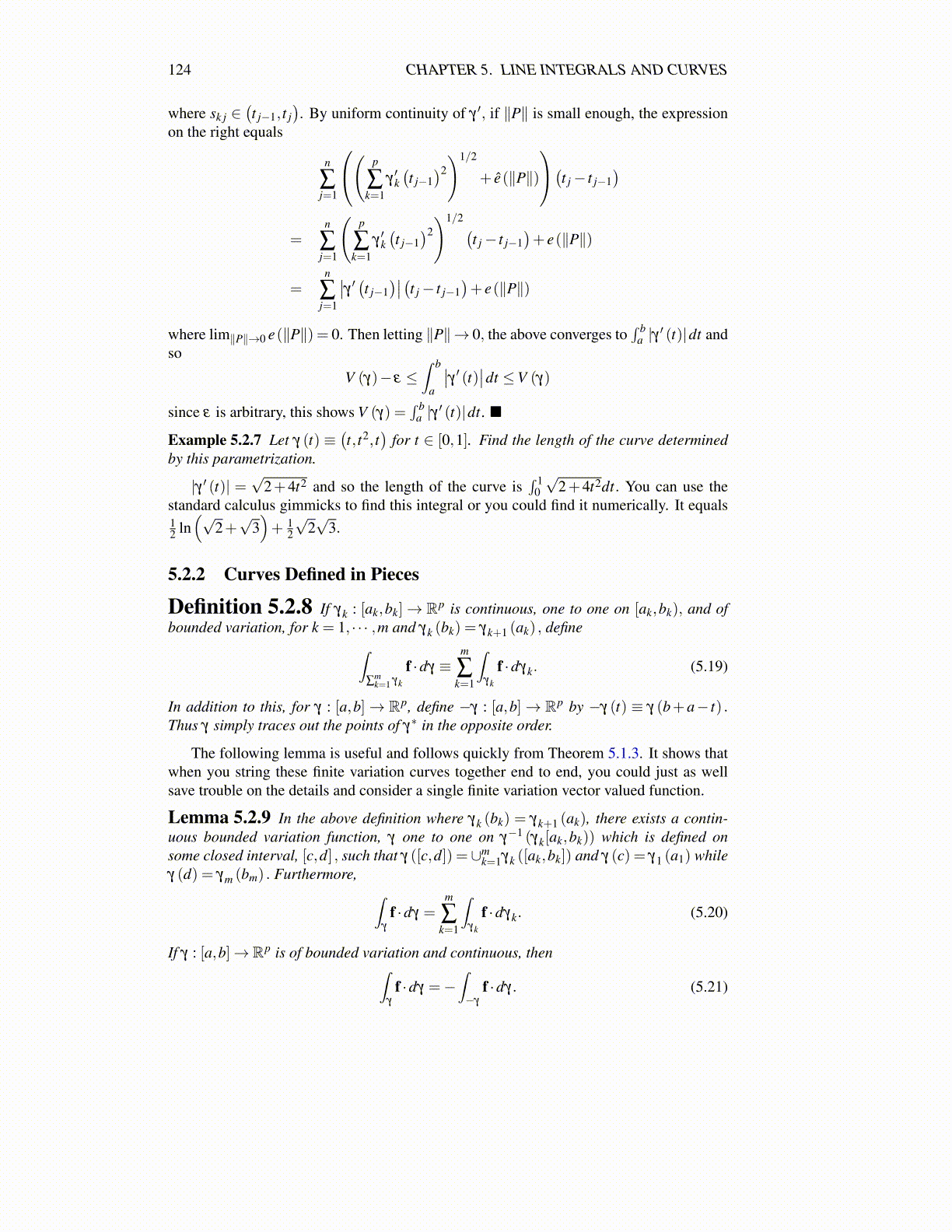
124 CHAPTER 5. LINE INTEGRALS AND CURVES
where sk j ∈(t j−1, t j
). By uniform continuity of γ ′, if ∥P∥ is small enough, the expression
on the right equals
n
∑j=1
( p
∑k=1
γ′k(t j−1
)2
)1/2
+ ê(∥P∥)
(t j− t j−1)
=n
∑j=1
(p
∑k=1
γ′k(t j−1
)2
)1/2 (t j− t j−1
)+ e(∥P∥)
=n
∑j=1
∣∣γ ′ (t j−1)∣∣(t j− t j−1
)+ e(∥P∥)
where lim∥P∥→0 e(∥P∥) = 0. Then letting ∥P∥→ 0, the above converges to∫ b
a |γ ′ (t)|dt andso
V (γ)− ε ≤∫ b
a
∣∣γ ′ (t)∣∣dt ≤V (γ)
since ε is arbitrary, this shows V (γ) =∫ b
a |γ ′ (t)|dt. ■
Example 5.2.7 Let γ (t) ≡(t, t2, t
)for t ∈ [0,1]. Find the length of the curve determined
by this parametrization.
|γ ′ (t)| =√
2+4t2 and so the length of the curve is∫ 1
0
√2+4t2dt. You can use the
standard calculus gimmicks to find this integral or you could find it numerically. It equals12 ln(√
2+√
3)+ 1
2
√2√
3.
5.2.2 Curves Defined in Pieces
Definition 5.2.8 If γk : [ak,bk]→ Rp is continuous, one to one on [ak,bk), and ofbounded variation, for k = 1, · · · ,m and γk (bk) = γk+1 (ak) , define∫
∑mk=1 γk
f ·dγ ≡m
∑k=1
∫γk
f ·dγk. (5.19)
In addition to this, for γ : [a,b]→ Rp, define −γ : [a,b]→ Rp by −γ (t) ≡ γ (b+a− t) .Thus γ simply traces out the points of γ∗ in the opposite order.
The following lemma is useful and follows quickly from Theorem 5.1.3. It shows thatwhen you string these finite variation curves together end to end, you could just as wellsave trouble on the details and consider a single finite variation vector valued function.
Lemma 5.2.9 In the above definition where γk (bk) = γk+1 (ak), there exists a contin-uous bounded variation function, γ one to one on γ−1 (γk[ak,bk)) which is defined onsome closed interval, [c,d] , such that γ ([c,d]) = ∪m
k=1γk ([ak,bk]) and γ (c) = γ1 (a1) whileγ (d) = γm (bm) . Furthermore, ∫
γ
f ·dγ =m
∑k=1
∫γk
f ·dγk. (5.20)
If γ : [a,b]→ Rp is of bounded variation and continuous, then∫γ
f ·dγ =−∫−γ
f ·dγ. (5.21)